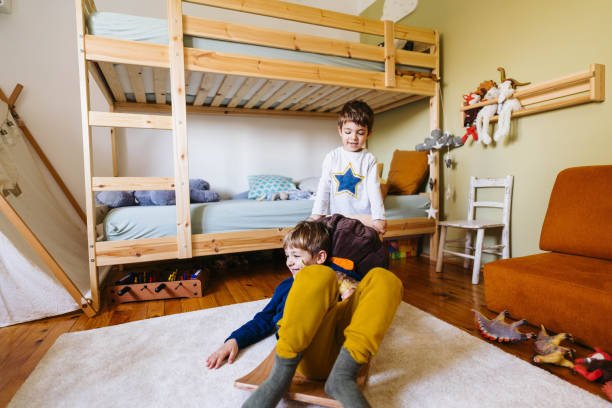Bedrooms are very important places for children, providing their own space where they are free to carve out their identity, play, study, chill out, and of course sleep. Often these rooms are small and may be shared with siblings, so it’s important to make the most of every inch of space. Here’s a look at some kid’s bedroom furniture ideas.
Invest in built-in storage
Kids may be small but they tend to generate a large amount of stuff: toys, games, books, tech gadgets, sports equipment, school kit—the list goes on. This can be difficult to manage at the best of times, and if your child is not naturally neat and tidy, the room can quickly descend into chaos.
This limits space for playing and study, and is also a trip hazard, and makes it harder to keep the room clean, pleasant and hygienic. Bespoke fitted furniture can be part of the solution, by maximising the amount of storage space available. For example, wardrobes can be designed to fit from floor to ceiling and wall to wall, so there is no dead space.
The wardrobes can also accommodate unique room dimensions, such as awkward alcoves and sloping ceilings that would otherwise be wasted.
Integrated desks and shelving units
Desk space is essential for children to do their homework and to enable them to pursue interests such as art and crafts. However, fitting a desk into a smaller room can be a challenge. Custom furniture offers the opportunity to integrate a desk with a wardrobe or shelving, or with a cabin bed, creating a practical and space saving solution.
Bespoke furniture can be designed with flexibility in mind, so that it can be reconfigured as your child grows or their needs change. For example, the wardrobe can be fitted with adjustable shelving, drawers or hanging space, as older children may need more room for school supplies or clothing and footwear.
Keeping it fun
Younger children spend a lot of time playing independently in their rooms, and this is an important developmental stage as their imaginative, problem solving and emotional skills evolve. The room can be made safe, fun and inviting with bright colours, and places to climb, hide, and generally burn off some energy.
Beds can be integrated with climbing walls, slides, and secret hiding compartments, for example. Wall murals can be both decorative and educational, such as world maps, galaxies, or picture alphabets.
Wall stickers that don’t damage paintwork are a great way to add interest, and can easily be changed as your child’s interests move on—it’s a lot easier than stripping off wallpaper that they have suddenly decided overnight that they hate!
Stickers, posters and so on are also a good way to give younger kids some autonomy over the design of their bedroom, helping them make independent decisions and develop their individual taste and sense of style.
Furnishing Your Dreams
Ask for a free quote

